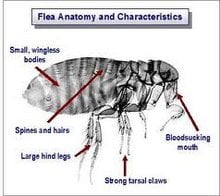The Greedy Cat Flea

What is a flea?
The answer is manifold. As you probably already know, there are plenty of different kinds of fleas. Many are named for the hosts that they prey upon: Rabbit, Dog, and Deer Fleas, etc. However, as we’ve already learned, knowledge of your enemies is of paramount importance in the ongoing struggle against parasites. So it’s time to get down to specifics. If there is one sort that gives people and pets more trouble than any other, it is undoubtedly the Cat Flea. If you’ve ever had to deal with a pet parasite infestation, you’ve more than likely come up against this tiny terror.
So what do fleas do?
 More than you might expect. The Cat flea is one of the most numerous creatures on the planet, thriving in any area inhabited by animals. Unlike many of their parasitic brethren with a predilection toward a single type of prey, these bloodsuckers have an undiscerning appetite for mammalian hemoglobin. They will feast on dogs, cats, birds, and even humans. Though humans can be infected, it’s difficult for a large colony to establish for any extended period of time. Most human beings are quick to eliminate any pesky itching, but if a flea can feed on a human for 12 hours they will begin to lay eggs. While they are predominantly found on cats, there are actually more cat fleas infesting dog skins than any other variety, including the dog flea.
More than you might expect. The Cat flea is one of the most numerous creatures on the planet, thriving in any area inhabited by animals. Unlike many of their parasitic brethren with a predilection toward a single type of prey, these bloodsuckers have an undiscerning appetite for mammalian hemoglobin. They will feast on dogs, cats, birds, and even humans. Though humans can be infected, it’s difficult for a large colony to establish for any extended period of time. Most human beings are quick to eliminate any pesky itching, but if a flea can feed on a human for 12 hours they will begin to lay eggs. While they are predominantly found on cats, there are actually more cat fleas infesting dog skins than any other variety, including the dog flea.
Cat Flea Characteristics
 Aside from being less finicky than the other types, the cat flea doesn’t really stand out. Their recognizable attributes only become visible when viewed under a microscope, which can be problematic considering how difficult they are to catch. They share most of the major features with the others, like piercing/sucking mouth parts, three sets of legs, large and powerful hind legs well-suited to jumping, tiny spines on their legs used to grip the host’s hair, and a triple sectioned body. Their habits are very similar to the other varieties as well. They prefer warmer climates anywhere between 55 and 90° F. Cat fleas are most active before laying eggs and after emerging from their pupa stage.
Aside from being less finicky than the other types, the cat flea doesn’t really stand out. Their recognizable attributes only become visible when viewed under a microscope, which can be problematic considering how difficult they are to catch. They share most of the major features with the others, like piercing/sucking mouth parts, three sets of legs, large and powerful hind legs well-suited to jumping, tiny spines on their legs used to grip the host’s hair, and a triple sectioned body. Their habits are very similar to the other varieties as well. They prefer warmer climates anywhere between 55 and 90° F. Cat fleas are most active before laying eggs and after emerging from their pupa stage.The major differences are in the whisker-like spines on and around their heads as well as a vertical compression, (in addition to the universally present lateral compression that allows all fleas to slip as they please through feathers and fur with equivalent ease). On an unrelated note, that last rhyme was entirely coincidental and unplanned, though whimsically pleasing to the ear. A certain amount of whimsy is a much-needed element when discussing a subject as disturbing as bloodsucking parasites, so it seems like a good spot to end the discussion.
Remember that while fleas can differ greatly between species, treatment is nearly always the same. Prevention is the best policy and nothing beats high quality pet medications. Grab yours today!






 All posts
All posts Tips and Tricks
Tips and Tricks Health and Welling
Health and Welling Product Reviews
Product Reviews Funny and Quirky
Funny and Quirky






Comment(s)0